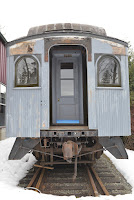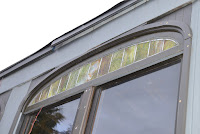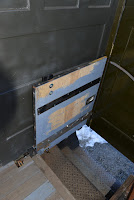 |
| Coach 213 platform “B” |
The Northwest Railway Museum has operated an interpretive railway since 1967. Since then, millions of people have ridden the train, and coaches have traveled thousands of miles. One of the longest-serving cars is coach 213, a former Spokane, Portland and Seattle Railway coach built by Barney and Smith in 1912. It is a sister to coach 218 – which was extensively rehabilitated and restored earlier this decade – and is built predominantly of wood. These two cars represent typical intercity passenger coaches used throughout Washington in the period prior to WW II.
Now it is coach 213’s turn: it is being completely rehabilitated, but unlike the 218 this work is being performed in phases so the car may remain in service during peak periods. With support from King County 4Culture‘s Heritage Capital program, major work has already been performed.
 |
|
| A renewed clerestory window |
Over the last two years, all the 213’s clerestory windows have been removed for rehabilitation. The zinc came that retains the individual pieces of glass has been renewed, and any broken or missing colored glass has been replaced. The mahogany frames have been stripped of old finishes, repaired as necessary, and refinished with varnish on the interior and an epoxy primer on the exterior. These windows will be installed as soon as a new canvas roof is applied.
 |
| Upper window sashes after re-installation |
Meanwhile, the upper “elliptical” sashes have been removed, rehabilitated and reinstalled. These window sashes required a little more work that the clerestory windows because all but one were missing their colored glass panels. The Museum’s incredible team of volunteers and staff restored the original zinc came and produced the missing glass. The effect is stunning, particularly when the sun passes directly through the milky green glass.
 |
| New platform trap |
The platforms on the end of a wood coach are particularly susceptible to deterioration. Mechanical wear and exposure to the elements are the chief factors, and improving the weather-resistance of the structure is key to its preservation. The platforms were taken apart, deteriorated steel components were replaced, and missing or deteriorated wood was replaced. Platform traps were patterned, manufactured, and installed. Meanwhile, the hand brake stand was rebuilt and a new brake handle installed.
 |
| New door and windows |
The platforms have many components and are one of the more complicated areas of the car to work on. Included in the scope work was replacement of four windows with elliptical tops, four platform doors also with elliptical tops, and even the platform ceilings where new LED platform lamps have now been installed. For now, this work will mostly appear in gray primer, but as the work advances everything will be colored SP&S coach green to match coach 218.
Car body siding has been addressed too. Extensive reworking of the cladding is sealing it from the weather and preparing it for the final color coats. And the next step will be rehabilitating the roof deck and re-applying a canvas roof. Exciting days are ahead for coach 213!
 |
| 213 with reworked cladding appearing in gray primer |

